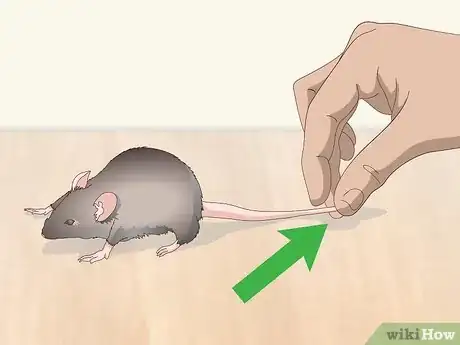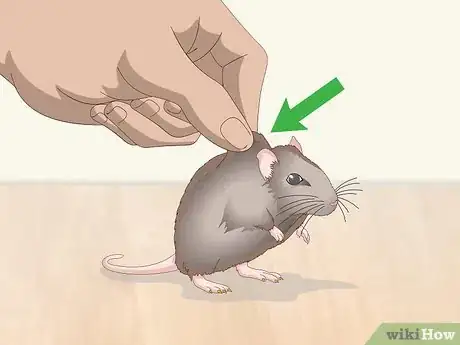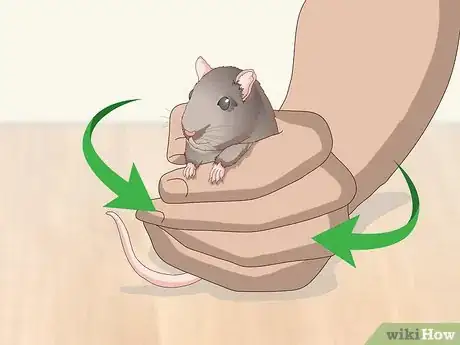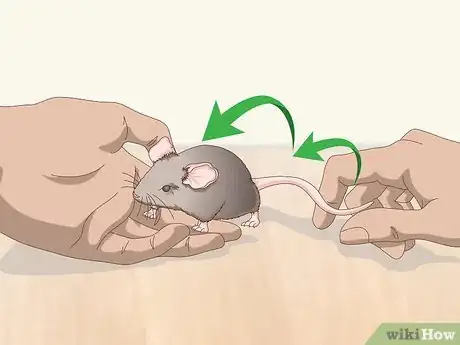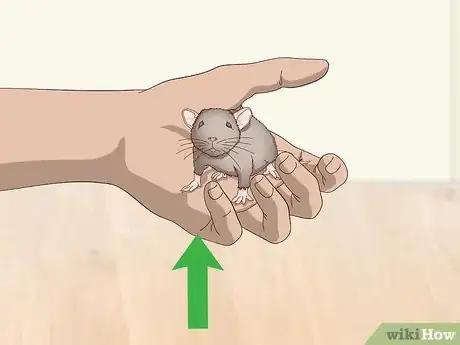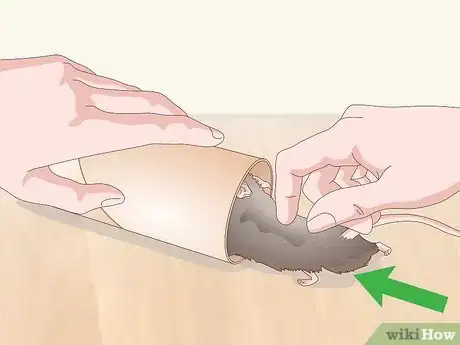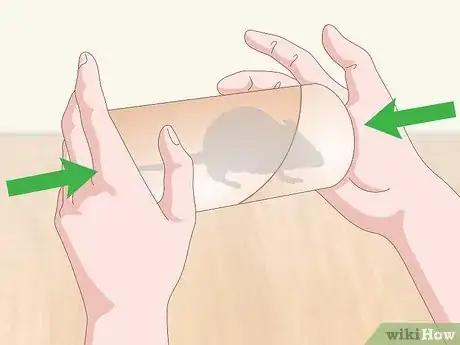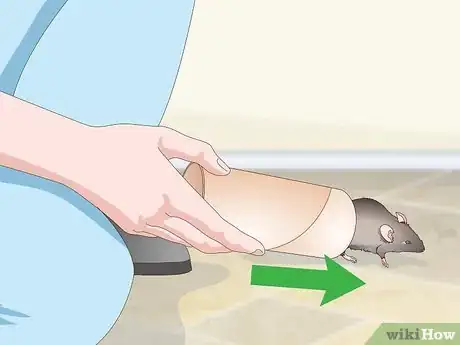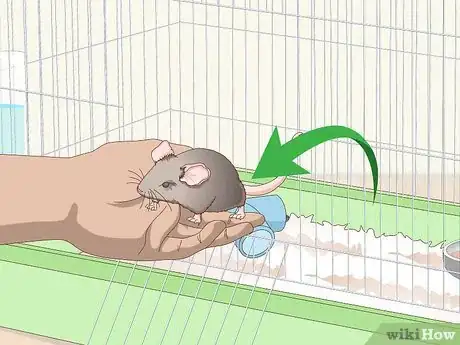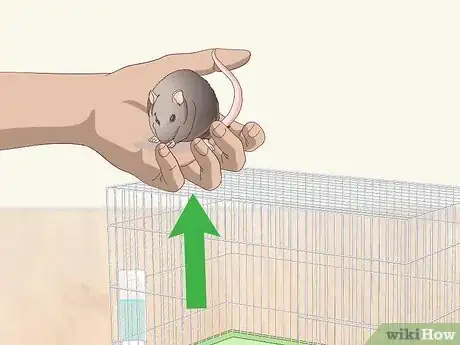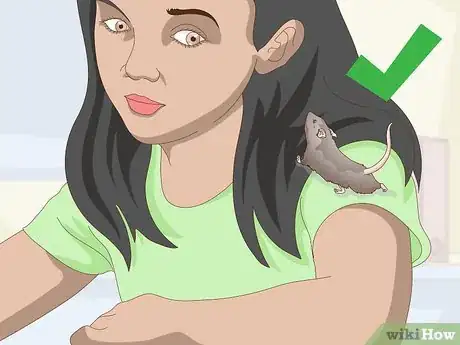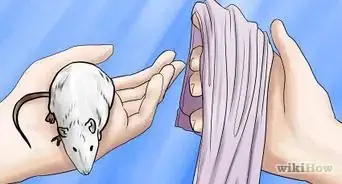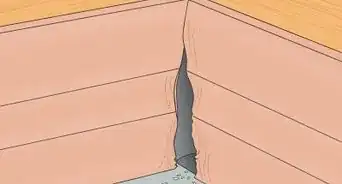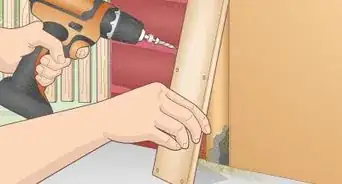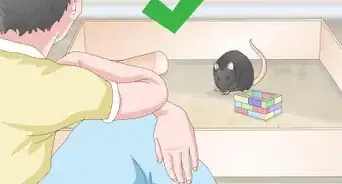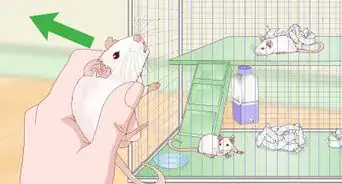X
This article was co-authored by Melissa Nelson, DVM, PhD. Dr. Nelson is a Veterinarian who specializes in Companion and Large Animal Medicine in Minnesota, where she has over 18 years of experience as a veterinarian in a rural clinic. She received her Doctor of Veterinary Medicine from the University of Minnesota in 1998.
This article has been viewed 34,409 times.
If you're a relatively new mouse owner, figuring out how to pick your pet up properly can be rather confusing. Thankfully, there are a number of safe, simple techniques you can use to lift your furry friend off the ground.
Steps
Method 1
Method 1 of 3:
Using Your Fingers
-
1Grasp your mouse's tail gently to restrain it. To keep your mouse from scurrying away while you try to pick it up, grab the center or base of its tail with your thumb and index finger. Mice tails are quite fragile, so your grip should be just firm enough to keep your pet from scampering off.
- Do not, under any circumstance, pick your mouse up by its tail. Doing so will cause your pet lots of discomfort and, in some cases, can lead to major injuries like degloving.[1] Degloving occurs when the mouse's flesh detaches from the bone around its tail.
-
2Grab the scruff of your mouse's neck firmly to hold it for a long time. Using your free thumb and index finger, grasp the loose skin located directly behind your mouse's ears. Make sure your grip is fairly firm, that way you don't drop your pet while lifting it.
- Grabbing your pet by the scruff of its neck is the most secure way to pick it up, making it the best option if you need to examine your mouse or hold it for a long time.
Advertisement -
3Wrap your hand around the mouse gently to hold it for a minute or less. If you plan on holding your mouse for a brief amount of time, you can scoop the animal up with your hand and gently close your fingers around it. If you end up holding the mouse for longer, change your grip to avoid harming your pet.[2]
- This grip is perfect if you want to pick your mouse up briefly and move it to a nearby spot or location.
-
4Let the mouse crawl onto your palm if you want to play with it. Place 1 of your hands in front of the mouse with your palm facing up. Then, release your pet's tail and let the mouse climb onto your palm. If the mouse refuses to climb on, gently slide your hand underneath the animal.
- This handling method is perfect if you want to play with the mouse. However, do not use this method to carry your pet since the mouse can jump off at any moment.
-
5Lift your mouse gently. Check that your mouse is secure, then carefully lift the animal up. If you haven't already, you can let go of the mouse's tail.
- Before lifting your mouse, make sure it's breathing properly. If your pet sounds short of breath, loosen your grip so it can get more air.
Advertisement
Method 2
Method 2 of 3:
Using a Tube
-
1Place a small tube in front of your mouse. Grab a small, hollow tube like a mouse tunnel or toilet paper roll. Then, place the tube in front of your pet, making sure that 1 of the object's openings points directly at your mouse's face.
- If you'd prefer, you can use a cup or other small container instead.[3]
-
2Guide your mouse into the tube. In some instances, your mouse will run into the tube completely on its own. In other instances, you'll have to guide your pet toward the tube by gently nudging it with your fingers.
- If necessary, place a small treat in front of the tube to make your mouse go near it. Some snacks mice love include fruits like banana slices and crispy veggies like celery.
-
3Cover the tube openings with your hands. Once your mouse is inside the tube, cover the ends of the container with the palms of your hands. This will prevent your mouse from falling out or escaping during transport.
- If your pet starts to squeak nervously, open your hands and let it out of the tube.
- If your mouse is particularly anxious, you may need to acclimate it to the tube by placing it inside for 15 to 30 second increments.
-
4Transport the tube and release your mouse. Once your mouse is safe and sound inside the tube, pick the container up and take it wherever you want. While transporting your mouse, make sure to keep the tube level and try not to move it around too much. When you reach your destination, lower the tube to the ground and let your mouse out.
- While transporting your mouse, don't forget to keep your hands firmly clasped over the tube's openings.
Advertisement
Method 3
Method 3 of 3:
Taming Your Mouse
-
1Place your hand in the mouse's cage. Wash your hands thoroughly with unscented soap and water to remove any smells that might confuse your mouse. Then, lower 1 of your hands into the mouse's cage and place it near your pet with the palm facing up.[4]
- Most mice enjoy being picked up, but only if they feel safe around the person holding them. Introducing your hand in this way may seem tedious, but it will teach your pet to trust you.
-
2Let the mouse walk onto your palm. Leave your hand in the cage for 10 to 15 minutes, giving your pet ample time to sniff and examine it. Once it feels safe, the mouse will walk onto your palm and start exploring it.[5]
- If the mouse does not walk onto your palm within 15 minutes, remove your hand from the cage and repeat the process the next day. It may take your pet multiple sessions to get used to your hand.
- If the mouse refuses to come near you, place a small treat in your hand to tempt it closer. Some good mouse treats include crunchy vegetables like carrots and sweet fruits like apples.
- If the mouse tries to bite you, gently slide it off your palm and remove your hand from the container.
-
3Raise your hand slowly. After the mouse walks onto your palm, give it a few seconds to get used to the new environment. Then, slowly raise your hand until it is between 3 and 4 in (7.6 and 10.2 cm) off the ground. Once your pet seems comfortable at this height, raise it another 3 to 4 in (7.6 to 10.2 cm). Repeat this process until you can lift the mouse up to your shoulders.
- If your mouse starts to wag its tail frantically, squeak nervously, or bite you, lower your hand back down to the cage so it can get off and calm down.
- If your mouse bites you, try not to jump back so you don't drop and injure it.
-
4Let the mouse explore your body. Once you've successfully lifted your mouse, it may attempt to walk onto your arms and shoulders. Letting your pet do this will make it more comfortable with general handling.[6]
- Mice love motion, so don't be afraid to move your hands, arms, and shoulders while your pet explores. It's best to try this while sitting at first, but the mouse may be able to eventually "ride" on your shoulder or arm.[7]
- Falls can be fatal to mice, even if the mouse is just a few feet up in the air. Wait until your mouse is used to being on you before you try moving with it. Mice are jumpers, so keep in mind that it might try to jump off of you if it's not comfortable yet.[8]
-
5Keep trying even if your mouse doesn't seem to like you. Your mouse needs to be tame for its own health and safety. You will need to be able to handle the mouse to clean its habitat, check it over to make sure it looks healthy, and take it to the vet. Even if the mouse doesn't seem to like you at first, you should continue to interact with it until it gets tame.
Advertisement
Warnings
- Mice are jumpers and could die if they jump out of your hand or off of a table, even if it's just a few feet high. Be careful when handling the mouse.[9]⧼thumbs_response⧽
Advertisement
References
- ↑ http://petmiceblog.co.uk/how-to-hold-a-pet-mouse/
- ↑ https://www.aspca.org/sites/default/files/upload/images/mouse_edu.pdf
- ↑ https://www.aspca.org/sites/default/files/upload/images/mouse_edu.pdf
- ↑ https://www.youtube.com/watch?v=AcGgiA5fFU8&feature=youtu.be&t=27s
- ↑ http://petmiceblog.co.uk/how-to-hold-a-pet-mouse/
- ↑ https://www.gov.mb.ca/agriculture/rural-communities/4h/pubs/small-animals-mice-rats.pdf
- ↑ http://www.afrma.org/caresheet.htm
- ↑ https://www.petful.com/other-pets/getting-pet-mice/
- ↑ https://www.petful.com/other-pets/getting-pet-mice/
About This Article
Advertisement
